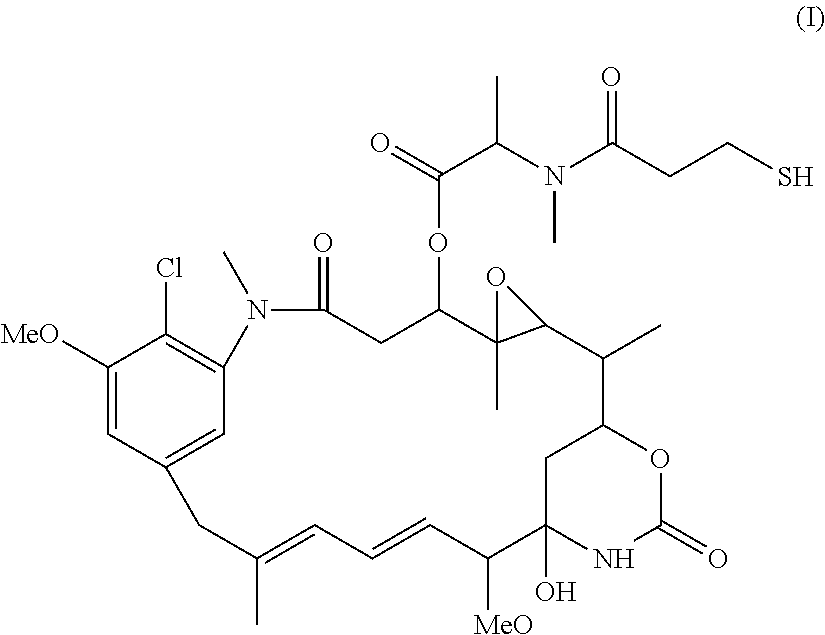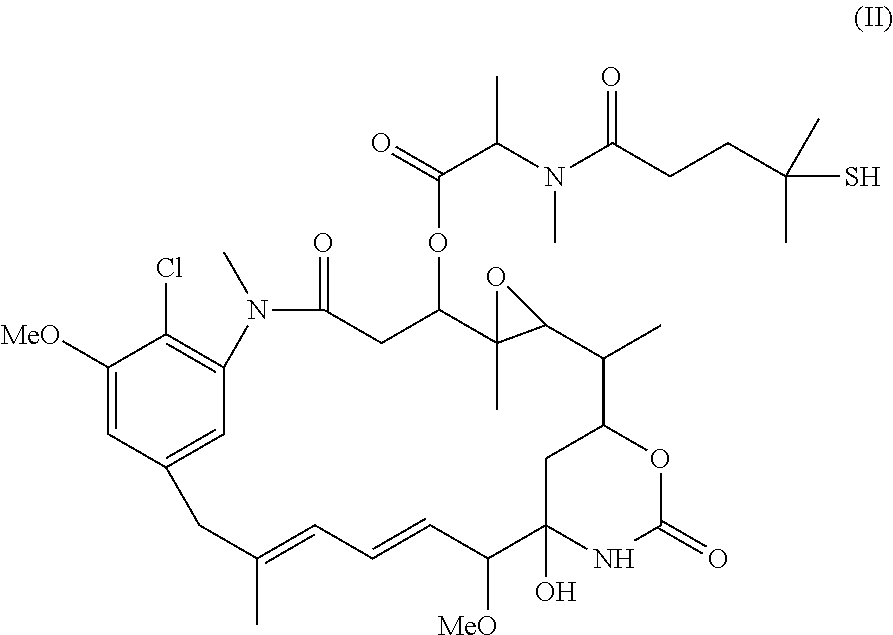Preparation of maytansinoid antibody conjugates by a one-step process
a technology of maytansinoid and antibody conjugate, which is applied in the field of preparation of maytansinoid antibody conjugate by a one-step process, can solve the problems of complex process that has been previously described for the manufacture of antibody-cytotoxic agent conjugate, and achieves the effect of high purity and/or stability of the conjuga
- Summary
- Abstract
- Description
- Claims
- Application Information
AI Technical Summary
Benefits of technology
Problems solved by technology
Method used
Image
Examples
example 1
[0101]Humanized CD37-3 antibody was reacted with the heterobifunctional crosslinking reagent SMCC and the maytansinoid DM1 using a previously described process (e.g. U.S. Pat. No. 5,208,020), as well as the one-step process that is the subject of the present application.
[0102]For the previously described process, huCD37-3 (15 mg / mL) first was reacted with SMCC (6.5-fold molar excess relative to the amount of antibody) to form the modified antibody. The modification reaction was performed at 16° C. in 50 mM sodium phosphate buffer (pH 6.9) containing 2 mM EDTA and 10% DMA for 90 minutes. The reaction was quenched with 1 M acetate to adjust the pH to 4.5 and the modified antibody was purified using a column of Sephadex G-25F resin equilibrated and eluted in 20 mM sodium acetate (pH 4.5) containing 2 mM EDTA. After purification, the modified antibody (5 mg / mL) was reacted with the maytansinoid DM1 (6.8-fold molar excess relative to the amount of antibody; 1.3-fold excess relative to th...
example 2
[0112]Humanized Folate Receptor antibody huMov19 (see U.S. Application Publication 2012 / 0009181) was reacted with the heterobifunctional crosslinking reagent sulfo-SPDB and the maytansinoid DM4 using two previously described processes, as well as the improved process that is the subject of the present application.
[0113]For the previously described Process A (two-step process, e.g. Chari et al., U.S. Pat. No. 5,208,020), huMov19 antibody (20 mg / mL) first was reacted with sulfo-SPDB (5.7-fold molar excess relative to the amount of antibody, dissolved in DMA, dimethylacetamide) to form the modified antibody. The modification reaction was performed at 20° C. in 50 mM EPPS (4-(2-hydroxyethyl)piperazine-1-propanesulfonic acid) buffer (pH 8.1) containing 5% DMA for 180 minutes. The modified antibody was purified using a column of Sephadex G-25F resin equilibrated and eluted in 50 mM EPPS (pH 8.1) with 2 mM EDTA (Ethylenediaminetetraacetic acid). After purification, the modified antibody (5...
example 3
[0120]This example demonstrates that the one-step process described herein can be used to make conjugates starting with a variety of linkers and maytansinoid cytotoxic agents.
[0121]Humanized huN901 antibody was mixed with Maytansinoid (DM1 or DM4) and then with Linker (Sulfo-SMCC, SMCC, SPDB, or SPP). The reaction was performed at 20° C. in 50 mM phosphate buffer (pH 7.5) containing 2 mM EDTA and 10% DMA for approximately 20-24 hours. The reaction mixture was then purified using a column of Sephadex G25F resin equilibrated and eluted in 10 mM sodium succinate (pH 5.0).
[0122]As shown in Table 3 below, the one-step reaction can be performed on different linker and maytansinoid combinations and yield conjugate with good MAR and monomer levels.
TABLE 3Making conjugates by using different linker andmaytansinoid combinationsConjugateLinkerDMxConjugate MARMonomer (%)Two-stepSPPDM13.596.8One-stepSPPDM13.497.5(Inventive)SPDBDM14.697.7SMCCDM44.595.1S-SMCCDM13.598.0SPDBDM43.897.3
[0123]All refer...
PUM
 Login to View More
Login to View More Abstract
Description
Claims
Application Information
 Login to View More
Login to View More - R&D
- Intellectual Property
- Life Sciences
- Materials
- Tech Scout
- Unparalleled Data Quality
- Higher Quality Content
- 60% Fewer Hallucinations
Browse by: Latest US Patents, China's latest patents, Technical Efficacy Thesaurus, Application Domain, Technology Topic, Popular Technical Reports.
© 2025 PatSnap. All rights reserved.Legal|Privacy policy|Modern Slavery Act Transparency Statement|Sitemap|About US| Contact US: help@patsnap.com



